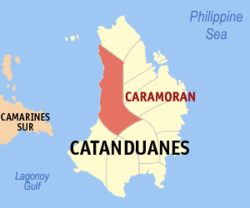Caramoran, Catanduanes
| Caramoran | |
|---|---|
| Municipality | |
 Map of Catanduanes with Caramoran highlighted |
|
| Location within the Philippines | |
| Coordinates: 13°59′N 124°08′E / 13.98°N 124.13°ECoordinates: 13°59′N 124°08′E / 13.98°N 124.13°E | |
| Country | Philippines |
| Region | Bicol (Region V) |
| Province | Catanduanes |
| District | Lone district |
| Founded | August 29, 1948 |
| Barangays | 27 |
| Government | |
| • Mayor | Agnes Borbe Popa |
| Area | |
| • Total | 263.74 km2 (101.83 sq mi) |
| Population (2015 census) | |
| • Total | 30,056 |
| • Density | 110/km2 (300/sq mi) |
| Time zone | PST (UTC+8) |
| ZIP code | 4808 |
| IDD : area code | +63 (0)52 |
| Website | www |
Caramoran is a third class municipality in the province of Catanduanes, Philippines. According to the 2015 census, it has a population of 30,056 people.
The main sources of livelihood of the town are growing rice, coconuts, and lasa and fishing. The white beaches and clean sea water of Toytoy and Sabang, the water falls of Ab-haw, Awinis and Garagag are some of the attractions, and together with the Hilacan River, are the main source of water for irrigation.
The municipality of Caramoran is located in the northern part of the island province of Catanduanes, about 87 kilometres (54 mi) from the capital town of Virac. From Tabaco, Albay, it can be reached by chartering a small passenger/cargo motorboat direct to Caramoran, or commercial ferry services like the M/V Eugenia, Starferry, or the fast sea vessel M/V Calixta to San Andres (Calolbon). From Virac or San Andres, a passenger jeepney or mini-bus can be taken to Caramoran.
The municipality has the largest land area of the municipalities in the province. It has a total land area of 26,374 hectares (65,170 acres) which is 16.7% of the total land area of the province.
Caramoran is bounded on the north by the municipality of Pandan, on the east by the municipalities of Viga, Panganiban and Bagamanoc, on the south by the municipalities of San Andres and Virac, on the west by Maqueda Channel.
Caramoran has a fair climate with two seasons, the dry season which starts during the months of April to August, and the wet season that occurs during September to March.
Gusty winds from the north-east occur during January to March, and from October to December. Typhoons occur in mid-year and in the later part of the year.
Caramoran is politically subdivided into 27 barangays.
The early Spanish missionaries who came to the Philippines landed in Napacahan, a sitio in Tubli and established a parish, which lasted for many years. In the parish church, St. John the Baptist had been venerated until this day as the Patron Saint (feast day June 24).
Early Caramoran history disclosed the fact that the town originated in Napacahan, but due to relentless and repeated Muslim piracy in the 17th to the 18th century, the town was transferred to its present site Caramoran poblacion where the Muslim pirates could not anchor because of barrier reefs.
...
Wikipedia

